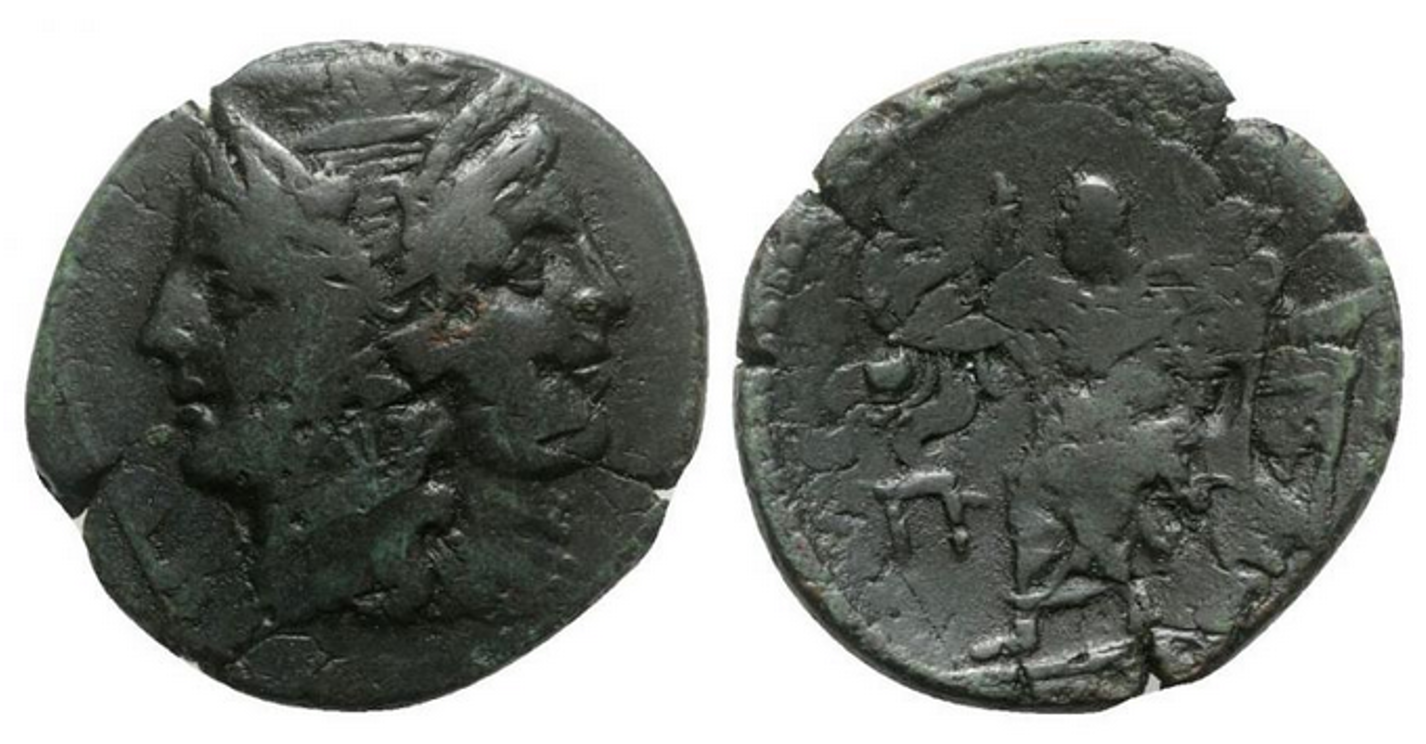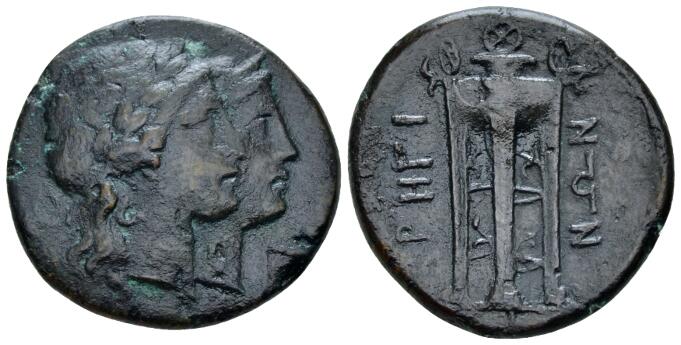216 BCE - 150 BCE | ΡΗΓΙΝΩΝ
Overstriking coin
SO 1418 - Rhegium over Rhegium.png
[1]
Overstruck variety
Rhegium Apollo Artemis tripod 215 BCE.jpeg
[2]
|
|
Sale(s)Sale(s) ᵖ:
|
Bertolami, EA 80, 18-21 Apr. 2020, 146
|
|
|
|
Description
| ObverseInscription or printing placed on the obverse.:
|
Janiform female head wearing polos.
|
ReverseInscription or printing placed on the reverse.:
|
ΡΗΓΙΝΩΝ (Greek) Asclepius seated one quarter left, holding scepter. Behind, bow? In left field, Π (value mark). Border of dots.
|
Mint and issuing power
| MintIdentifies the place of manufacture or issue of a numismatic object.:
|
Rhegium
|
Ancient regionAncient region.
|
Bruttium
|
Modern countryModern country: Italy
|
AuthorityIdentifies the issuing power. The authority can be "pretended" when the name or the portrait of X is on the coin but he/she was not the issuing power. It can also be "uncertain" when there is no mention of X on the coin but he/she was the issuing power according to the historical sources:
|
|
Chronology
| FromIdentifies the initial date in a range assigned in a numismatic context. 216 BCE toIdentifies the final date in a range assigned in a numismatic context.. 150 BCE
|
Hellenistic 323-30 BC  periodTime period of the numismatic object. periodTime period of the numismatic object.
|
Physical description
MetalThe physical material (usually metal) from which an object is made.: Bronze 
|
WeightWeight of the numismatic object (in grams). in grams: 10.5410.54 g <br />10,540 mg <br />
|
DenominationTerm indicating the value of a numismatic object. Examples: tetradrachm, chalkous, denarius.: pentonkion
|
AxisDescribes the directional relationship between the obverse and reverse of a numismatic object.: 22 mm <br />0.2 cm <br />
|
| DiameterDescribes diameter of an object (in mm).: 2525 mm <br />2.5 cm <br />
|
|
References
Description
| ObverseInscription or printing placed on the obverse.:
|
Jugate heads of Apollo and Artemis right (visible on reverse: almost everything)
|
ReverseInscription or printing placed on the reverse.:
|
ΡΗΓΙΝΩΝ (Greek) Tripod.
|
Mint and issuing power
| MintIdentifies the place of manufacture or issue of a numismatic object. ᵖ:
|
Rhegium
|
Ancient regionAncient region. ᵖ
|
Bruttium
|
Modern countryModern country: Italy
|
AuthorityIdentifies the authority in whose name (explicitly or implicitly) a numismatic object was issued. ᵖ:
|
|
Chronology
| FromIdentifies the initial date in a range assigned in a numismatic context. 260 BCE toIdentifies the final date in a range assigned in a numismatic context.. 215 BCE
|
Hellenistic 323-30 BC  periodTime period of the numismatic object. periodTime period of the numismatic object.
|
Physical description
| DenominationTerm indicating the value of a numismatic object. Examples: tetradrachm, chalkous, denarius. ᵖ:
|
trias
|
|
|
References
References
- a b Rutter N. Keith et alii (eds.) (2001), Historia Numorum Italy, London, xvi, 223 p., 43 pl.
- ^ Hoover, Oliver D. (2018), The Handbook of Greek Coinage Series, Volume 1. Handbook of Coins of Italy and Magna Graecia, Sixth to First Centuries BC., Lancaster-London, 2018, lxi, 527 pages, 23 cm

